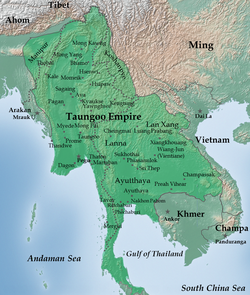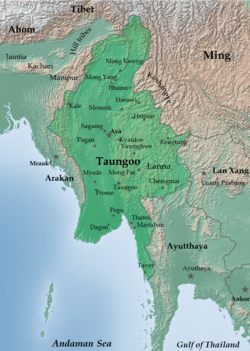Toungoo dynasty တောင်ငူမင်းဆက် taungnguumainn saat | |
|---|---|
| 1510–1752 | |
 Toungoo Empire at its greatest extent (1580) | |
 The restored Taungoo or Nyaungyan Dynasty c. 1650 | |
| Status | Empire |
| Capital | Toungoo (Taungoo) (1510–1539) Pegu (Bago) (1539–1599) Ava (Inwa) (1599–1613) Pegu (Bago) (1613–1635) Ava (Inwa) (1635–1752) |
| Common languages | Official Burmese |
| Religion | Official Theravada Buddhism Minority |
| Government | Absolute monarchy |
• 1485–1530 | Mingyi Nyo |
• 1530–1550 | Tabinshwehti |
• 1550–1581 | Bayinnaung |
• 1605–1628 | Anaukpetlun |
• 1629–1648 | Thalun |
• 1733–1752 | Mahadhammaraza Dipadi |
| Legislature | Hluttaw |
| History | |
• Toungoo dynasty founded | 1485 |
• Independence from Ava | 16 October 1510 |
| 1510–1599 | |
| 1599–1752 | |
• Hanthawaddy conquest | 23 March 1752 |
| Population | |
• Census | 1,982,000 - 2,313,000[citation needed] |
| Currency | Ganza kyat and silver kyat |
| Today part of | |
| History of Myanmar |
|---|
 |
|
|
|
|
|
|
The Toungoo dynasty (Burmese: တောင်ငူမင်းဆက်, [tàʊɰ̃ŋù mɪ́ɰ̃ zɛʔ]; also spelt Taungoo dynasty), and also known as the Restored Toungoo dynasty, was the ruling dynasty of Burma (Myanmar) from the mid-16th century to 1752. Its early kings Tabinshwehti and Bayinnaung succeeded in reunifying the territories of the Pagan Kingdom for the first time since 1287 and in incorporating the Shan States for the first time, in addition to including Manipur, Chinese Shan States, Siam and Lan Xang.[1] At its peak, the Toungoo Empire was the largest and strongest empire in Southeast Asia. However, it collapsed in the 18 years following Bayinnaung's death in 1581.
The dynasty quickly regrouped under the leadership of Nyaungyan Min and his son, Anaukpetlun, who succeeded in restoring a smaller, more manageable kingdom, encompassing Lower Burma, Upper Burma, Shan States and Lan Na by 1622. The Restored Toungoo kings, now based in Ava (Inwa), created a legal and political system whose basic features would continue under the Konbaung dynasty well into the 19th century. The crown completely replaced the hereditary chieftainships with appointed governorships in the entire Irrawaddy valley and greatly reduced the hereditary rights of Shan chiefs. Its trade and secular administrative reforms built a prosperous economy for more than 80 years.
The kingdom entered a gradual decline due to the "palace rule" of its kings. Starting from the 1720s, the kingdom was beset with raids by the Meitei people of the Chindwin River, and a rebellion in Chiang Mai. Raids by the Meitei intensified in the 1730s, reaching increasingly deeper parts of central Burma. In 1740, the Mon people in Lower Burma began a rebellion, founding the Restored Hanthawaddy Kingdom. The Hanthawaddy armies captured Inwa in 1752 and ended the 266-year-old Toungoo dynasty.
- ^ Lieberman, Victor B. (14 July 2014). Burmese Administrative Cycles: Anarchy and Conquest, c. 1580-1760. Princeton University Press. p. 16. ISBN 978-1-4008-5585-8. Archived from the original on 26 September 2021. Retrieved 18 January 2021.